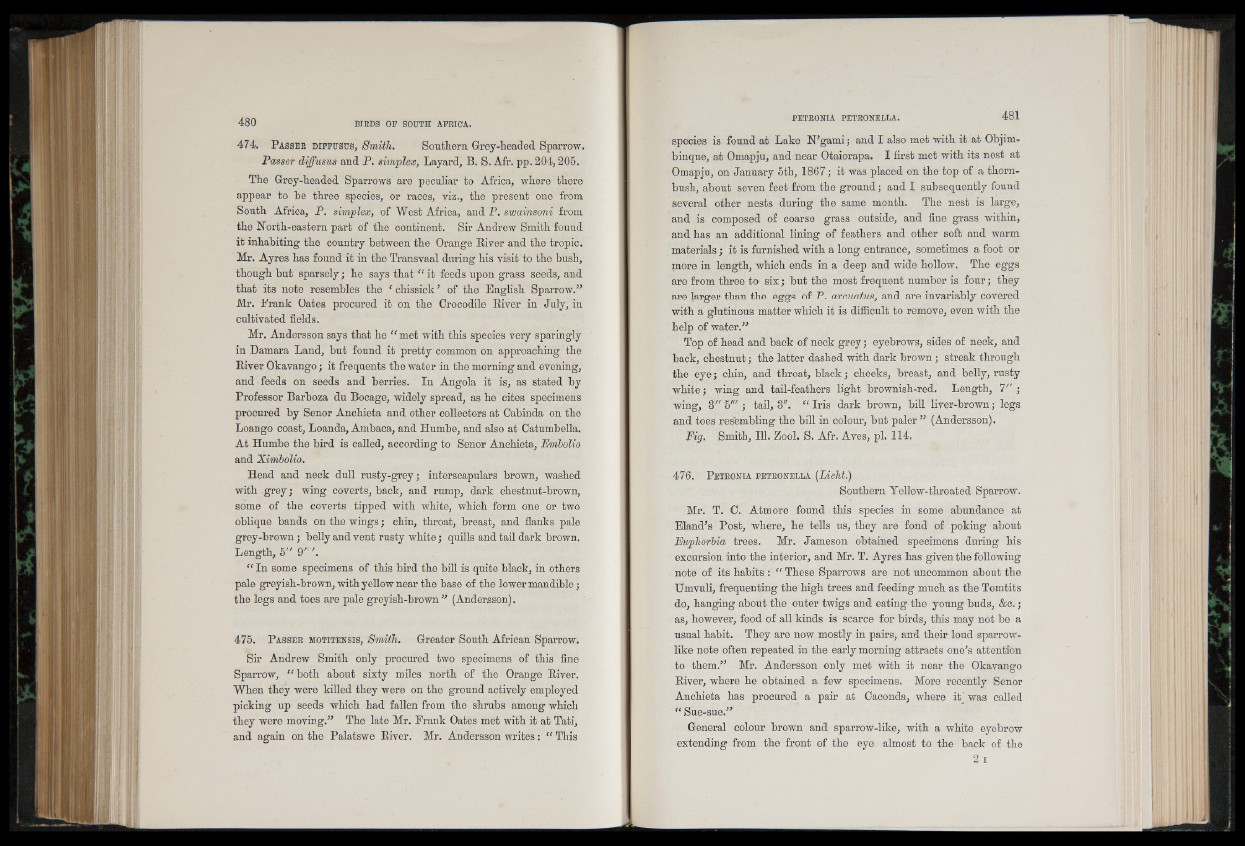
474. P a sser d if fu s e s , Smith. Southern Grey-headed Sparrow.
Passer diffusus and P. simplex, Layard, B. S. Afr. pp. 204,205.
The Grey-headed Sparrows are peculiar to Africa, where there
appear to be three species, or races, viz., the present one from
South Africa, P. simplex, of West Africa, and P. swainsoni from
the North-eastern part of the continent. Sir Andrew Smith found
it inhabiting the country between the Orange River and the tropic.
Mr. Ayres has found it in the Transvaal during his visit to the bush,
though but sparsely; he says that “ it feeds upon grass seeds, and
that its note resembles the c chissick ’ of the English Sparrow.”
Mr. Frank Oates procured it on the Crocodile River in July, in
cultivated fields.
Mr. Andersson says that he “ met with this species very sparingly
in Damara Land, but found it pretty common on approaching the
River Okavango; it frequents the water in the morning and evening,
and feeds on seeds and berries. In Angola it is, as stated by
Professor Barboza du Bocage, widely spread, as he cites specimens
procured by Senor Anchieta and other collectors at Cabinda on the
Loango coast, Loanda, Ambaca, and Humbe, and also at Catumbella.
At Humbe the bird is called, according to Senor Anchieta, Embolio
and Ximbolio.
Head and neck dull rusty-grey; interscapulars brown, washed
with grey; wing coverts, back, and rump, dark chestnut-brown,
some of the coverts tipped with white, which form one or two
oblique bands on the wings; chin, throat, breast, and flanks pale
grey-brown; belly and vent rusty white; quills and tail dark brown.
Length, 5" 9*
“ In some specimens of this bird the bill is quite black, in others
pale greyish-brown, with yellow near the base of the lower mandible;
the legs and toes are pale greyish-brown” (Andersson).
475. P a s s er mot iten s is , Smith. Greater South African Sparrow.
Sir Andrew Smith only procured two specimens of this fine
Sparrow, “ both about sixty miles north of the Orange River.
When they were killed they were on the ground actively employed
picking up seeds which had fallen from the shrubs among which
they were moving.” The late Mr. Frank Oates met with it at Tati,
and again on the Palatswe River. Mr. Andersson writes: “ This
species is found at Lake N’gami; and I also met with it at Objim-
binque, at Omapju, and near Otaiorapa. I first met with its nest at
Omapju, on January 5th, 1867; it was placed on the top of a thorn,
bush, about seven feet from the ground; and I subsequently found
several other nests during the same month. The nest is large,
and is composed of coarse grass outside, and fine grass within,
and has an additional lining of feathers and other soft and warm
materials; it is furnished with a long entrance, sometimes a foot or
more in length, which ends in a deep and wide hollow. The eggs
are from three to six; but the most frequent number is four; they
are larger than the eggs of P. arcuatus, and are invariably covered
with a glutinous matter which it is difficult to remove, even with the
help of water.”
Top of head and back of neck grey; eyebrows, sides of neck, and
back, chestnut; the latter dashed with dark brown; streak through
the eye; chin, and throat, black; cheeks, breast, and belly, rusty
white; wing and tail-feathers light brownish-red. Length, 7” ;
wing, 3” 5'" ; tail, 3". “ Iris dark brown, bill liver-brown; legs
and toes resembling the bill in colour, but paler’’ (Andersson).
Fig. Smith, HI. Zool. S. Afr. Aves, pi. 114.
476. P etronia petronella (Licht.)
Southern Yellow-throated Sparrow.
Mr. T. 0. Atmore found this species in some abundance at
Eland’s Post, where, he tells us, they are fond of poking about
Euphorbia trees. Mr. Jameson obtained specimens during his
excursion into the interior, and Mr. T. Ayres has given the following
note of its habits : “ These Sparrows are not uncommon about the
Umvuli, frequenting the high trees and feeding much as the Tomtits
do, hanging about the outer twigs and eating the young buds, &c.;
as, however, food of all kinds is scarce for birds, this may not be a
usual habit. They are now mostly in pairs, and their loud sparrowlike
note often repeated in the early morning attracts one’s attention
to them.” Mr. Andersson only met with it near the Okavango
River, where he obtained a few specimens. More recently Senor
Anchieta has procured a pair at Caconda, where itj was called
“ Sue-sue.”
General colour brown and sparrow-like, with a white eyebrow
extending from the front of the eye almost to the back of the
2 i